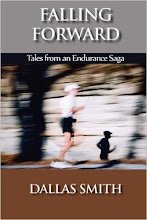*
*
The video clip from Fox News shows a runner collapsing within a few feet of the finish line at the Chicago Marathon of October 12, 2008.
The runner braced himself on the side wall and gingerly regained his feet. His knees buckled and he crumpled to the pavement again. Standing no longer possible, the fallen man seemed dazed for a bit, casting around for what to do.
The decision came. He started crawling toward his goal, smartly closing the distance. All the while, other runners streamed by, ignoring the man, “dashing to the finish line,” the announcer said. The crawler ignored everyone.
Soon two male runners stooped down, lifted him by the arms and escorted him across the line. Their kindness was presented as a good deed and the two runners were hailed as heroes. The men acted from the best human impulses of compassion and pity. The incident was both “heart wrenching and heart warming,” one TV anchor said.
A marathoner sees the men’s action differently: it was wrong.
The runner had not sought help and did not need it. When the two men jerked him up, they snatched away the challenge he had set himself—just when victory was near. Equally wearisome, they disqualified him. With their aid, the stricken runner managed a better finish position than those behind him who ran with no help. That is unfair; it violates a fundamental rule. Namely, no runner is allowed to have help from anyone other than race officials.
Runners disabled by various ailments—exhaustion, digestive upset, leg cramps, etc., even death—are hardly rare in a marathon. In fact, one runner died and scores landed in the hospital at this very marathon in 2007, due in part to unseasonably warm temperatures. At the big urban marathons, I’ve read that directors expect a death every two years.
In the present case, medics, trained and equipped, stood nearby ready to help the exhausted runner as soon as he needed it.
In the San Francisco marathon just two months earlier, I recall seeing a man on the pavement a half mile from the finish. Medics had covered him with a blanket and were giving treatment. So, stricken runners are not unusual.
In the Ironman contests, crawling is so historically honored as to be singled out in the rules. On page 25 of the Ironman Florida booklet, for the marathon portion, I find this sentence: “1) NO FORM OF LOCOMOTION OTHER THAN RUNNING, WALKING OR CRAWLING IS ALLOWED” (capitalized in the booklet).
Julie Moss set the standard. It was 1982 and Ironman Hawaii was being broadcast on network television for the first time, by ABC Wide World of Sports. As front-runner Moss approached the finish line, her strength bled out. Running, even standing, became impossible despite repeated attempts.
Attempts grew feebler. Her limbs folder like linked bars. She fell in a heap. She entered a new realm. Crawling was the only choice left. She crawled.
She crawled, the crowd pressed in, it was pandemonium. TV viewers and spectators alike had never seen anything like it—an athlete determined enough to crawl, a woman athlete at that. In the confusion, the woman who had chased Moss all day now passed her without knowing it. She took the win but few remember her name.
What they remember is the searing courage of Julie Moss. No one dragged her across the finish line. Had that happened, the world would have been denied maybe the bravest performance ever seen in sports.
One person inspired by her performance was swimmer Mark Allen, classmate of Julie Moss at San Diego State. Allen, too, took up Ironman triathlon, eventually going on to win six Ironman world championships. Outside magazine called him the most (physically) fit man in America.
Julie Moss and Mark Allen married and had a son named Mats. His genetic potential for extraordinary endurance must be a good bet.
So, yes, sometimes racers crawl. You don’t want to do that, to have to do that. At the least, it signifies you mismanaged your race, as apparently the man in Chicago did.
What of that Chicago runner who was crawling to the finish when he received help? What about his results? Was he disqualified?
Truth is, I don’t know. I expect the director reviewed his case and relaxed the rule about receiving aid, letting his time stand. This resolution is a just one, especially if no age-group awards were involved. The director would recognize a decisive circumstance: The runner had not asked for help and was physically unable to resist it—kidnapped as he was.




